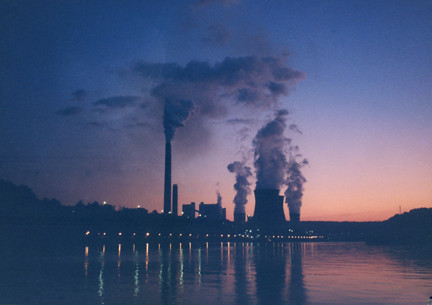FirstEnergy has a coal ash problem, and it wants us to deal
with it. Since 1975, the Beaver County
power plant has pumped about 20 billion gallons of ash mixed with water to an
impoundment called Little Blue Run on the border of Pennsylvania and West Virginia. The problem is that the ash is toxic: it
contains loads of heavy metals such as arsenic, lead, and cadmium, and other
harmful pollutants like selenium and boron.
For years, this pollution has been finding its way into groundwater,
wells, and streams, and even the air as the ash dries and blows around.
In 2012, FirstEnergy was ordered to close Little Blue Run
because of the well-documented damage it was doing to the surrounding
environment, nearby property, and neighbors’ health. So FirstEnergy began to look for other places
to dispose of this toxic waste. It has
now set its sights on the landfill at the Hatfield’s Ferry power station, a
plant that FirstEnergy abruptly retired in 2013. The ash would be dried out, loaded onto
barges, hauled up the Ohio and Monongahela Rivers for 113 miles, then
unloaded onto trucks and dumped at the landfill across the river from
Masontown.
| The proposed route between Little Blue Run (upper left) and Hatfield's Ferry (lower right) along the Ohio and Monongahela Rivers. |
But this landfill has its own set of problems. The original landfill had no liner, and toxins
from the ash disposed there have been contaminating the groundwater and surface
water since at least 2001. The most
severe contamination is from arsenic, which has been found in concentrations up
to 342 times the legal limit in monitoring wells around the site. Exposure to arsenic can cause damage to the
liver, kidneys, brain and nervous system, and can cause cancer. Other contaminants that exceed federal
standards are aluminum, boron, chromium, manganese, molybdenum, sulfate, and
total dissolved solids (TDS). There are
at least seven private water wells within a two mile radius that are at risk of
groundwater contamination, and one public water intake.
In 2006, the landfill was expanded and the new portion
included a liner. However, the original
landfill remains unlined, and continues to leach pollutants. The new lined portion partially overlaps the
old portion, so it is difficult to know whether the liner is actually
preventing additional toxins from contaminating groundwater.
In 2008, the landfill’s operator was fined for the
contamination, and order to take corrective measures. However, it is not clear that these
corrective actions have been consistently followed, or whether new pollution
continues to leach out from the site.
 |
| A view of Little Blue Run courtesy of vice.com. Click the image for Vice's coverage of this impoundment. |
FirstEnergy is desperately trying to avoid having to build a
new coal ash landfill that meets current federal standards for disposal of this
waste that has already proven to be dangerous.
So they are trying to find the cheapest way possible to get rid of
it. First it announced it would ship it
to the unlined pit in Labelle, but ongoing pollution problems at that site have
prevented it from being able to accept waste from new sources. So now the company has turned its attention
to the Hatfield’s Ferry dump, yet another site with unresolved problems. FirstEnergy, three strikes and you’re out.
In addition to the risks posed at the sites themselves, the
transportation of the ash on open barges risks contaminating the
Monongahela. The Mon has long suffered
from industrial pollution and acid mine drainage, and was at one time mostly
dead ecologically. However, it has begun
to recover, and was voted River of the Year in 2013. Multiple efforts are underway to encourage
river-centered tourism and recreation, and transportation of millions of tons of
toxic waste on open barges seems incompatible with that vision.
The Sierra Club, represented by
Earthjustice, appealed a decision by the Pennsylvania Department of
Environmental Protection (DEP) allowing FirstEnergy Generation, LLC to dispose
of more than 17 million tons of toxic coal ash from the Bruce Mansfield Power
Plant into a closed power plant landfill in Western Pennsylvania.
 |
| Bruce Mansfield power plant. |
In response to the DEP’s approval of
the permit Charles McPhedran an attorney from Earthjustice and Tom Schuster,
Pennsylvania Beyond Coal Campaign Representative for the Sierra Club released
the following statements:
“This permit puts neighbors at risk” Charles
McPhedran, an attorney with Earthjustice said.
“There are several private water wells and one public water intake that
are at risk from contamination from this site, not to mention the risk up and
down the rivers from transport of this ash. DEP needs to protect the families of Western Pennsylvania, not make them
a dumping ground for FirstEnergy.”
“Toxins from the ash disposed at the
Hatfield’s Ferry site have been contaminating nearby water since at least 2001.
Arsenic has been found in concentrations up to 342 times the legal limit in
monitoring wells around the site, and continues to violate health standards”
Tom Schuster, Pennsylvania Beyond Coal Campaign Representative for the Sierra
Club said. “Exposure to arsenic can cause damage to the liver, kidneys, brain
and nervous system, and can cause cancer.
DEP needs to protect this community and require FirstEnergy to clean up
this site before any more toxic ash is dumped.”
The Department of Environmental Protection should not issue
a permit to all FirstEnergy to simply move its toxic liability from one
community to another. If it must dispose
of its ash at Hatfield’s Ferry, it should be required to completely clean up
the existing site, line the entire landfill, and monitor extensively to ensure
new pollution does not occur. Better
yet, the company should avoid barging the ash up our rivers altogether, and build
a state of the art landfill on site.

No comments:
Post a Comment